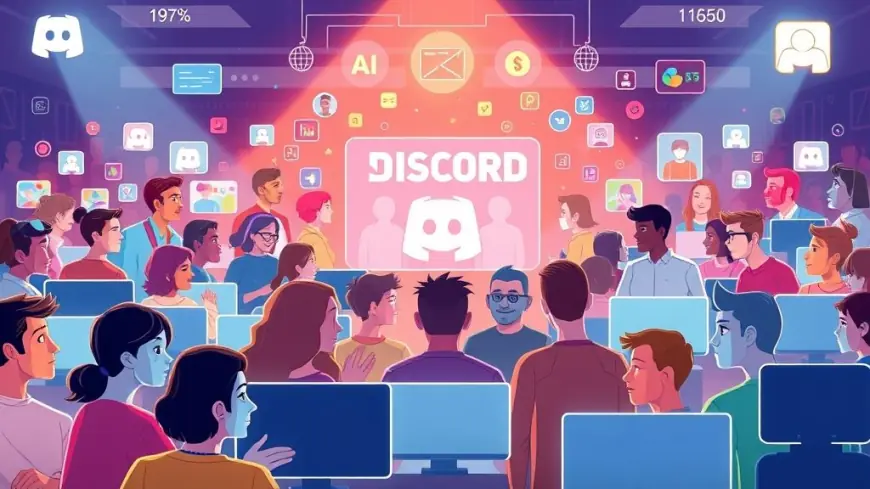From Zero to Thousands: Case Studies in Discord Community Building
Discover how successful projects scaled their Discord communities from scratch to thousands of active users. Real case studies and actionable tips included.

In the fast-evolving world of online communities, Discord has emerged as one of the most powerful platforms for building engaged, loyal, and self-sustaining user bases. Originally designed for gamers, Discord has transformed into a multifaceted hub for creators, startups, NFT projects, DAOs, SaaS companies, educators, and just about any group seeking a private, interactive online space.
But what separates successful communities with thousands of active users from the ones that fizzle out? The secret lies in strategy, persistence, and a deep understanding of the target audience. In this article, we’ll examine real-world case studies and the tactics used to grow communities from zero to thousands of active members on Discord.
Why Discord? Understanding the Platform’s Appeal
Before diving into the case studies, it’s important to understand why Discord has become the platform of choice for community builders:
-
Customizability: From private channels to bots and integrations, Discord allows communities to design their own unique experience.
-
Real-time interaction: Voice chats, live streams, and community discussions build trust and connection.
-
Role-based access control: Enables structured participation and rewards for contributions.
-
Strong developer support: API integrations and bot creation empower automation and personalization.
With that foundation in place, let’s look at how real communities have scaled from nothing to thriving ecosystems.
Case Study 1: Axie Infinity – Gaming + NFT
Starting Point: Axie Infinity began as a niche play-to-earn game with only a handful of testers and early adopters.
Tactics Used:
-
Early Incentivization: Players who joined early got access to rare in-game NFTs and tokens. This exclusivity drove initial traffic.
-
Community Roles and Gamification: Axie introduced community ranks and roles for contributors, moderators, and evangelists.
-
Localization & Subcommunities: As their global audience grew, they launched language-specific channels and empowered local leaders to manage them.
-
Real-Time Support: Dedicated mods and community managers provided help for onboarding, gameplay, and wallet issues, increasing user retention.
Results: Axie’s Discord community grew from a few hundred users to over 800,000+ at its peak. The community became a key pillar of their marketing and user support infrastructure.
Case Study 2: SaaS Founders Hub – Startup Networking Space
Starting Point: A small SaaS startup founder started a Discord server as a place for mutual learning and collaboration between SaaS entrepreneurs.
Tactics Used:
-
Weekly Events & AMAs: The founder invited experts in sales, growth, and development to host live sessions every week.
-
Channel Segmentation: Different channels for tech, marketing, funding, and hiring made the server organized and value-driven.
-
Mentorship Roles: Senior founders were invited to act as mentors, getting a special badge and private lounge access.
-
Partnerships: The founder collaborated with SaaS newsletters and podcasts to promote the server.
Results: The server grew organically to over 12,000 users in under a year, with high engagement and low churn. Today, it’s a go-to hub for early-stage SaaS founders.
Case Study 3: Cool Cats – NFT Community Building from Scratch
Starting Point: Cool Cats was a new NFT collection competing in a crowded market. They knew community hype would make or break their launch.
Tactics Used:
-
Pre-Mint Hype Channels: Before the NFT drop, the team created teaser content, riddles, and sneak peeks exclusively in Discord.
-
“Whale” Roles and Private Channels: Users who committed to buying in bulk or promoted Cool Cats early were given exclusive roles and early access.
-
Fan Art and Creator Contests: Encouraged fans to create art, memes, and animations in exchange for recognition and prizes.
-
Moderation Bot Automation: To handle the flood of new users and spam, Cool Cats used bots to automate onboarding and verify new members.
Results: Discord became the heart of Cool Cats' viral launch strategy. The server grew to over 100,000 users and helped drive millions in NFT sales.
Case Study 4: Kernel – Education Meets Community
Starting Point: Kernel is a curated Web3 fellowship program. They needed a platform to facilitate collaboration among builders, mentors, and learners.
Tactics Used:
-
Cohort-Based Structure: Each batch had its own private channels and curriculum, allowing focused collaboration.
-
Integrated Learning Resources: Discord bots delivered learning modules, reminders, and reading material.
-
Showcase & Demo Days: Kernel used Discord voice and stage channels to host live demos and discussions.
-
Value-Based Moderation: They maintained strict moderation guidelines based on kindness, curiosity, and contribution.
Results: Over multiple cohorts, Kernel grew to a vibrant ecosystem of 10,000+ builders. Alumni stayed engaged, creating long-term community retention.
Case Study 5: MidJourney – AI + Art
Starting Point: MidJourney, an AI image-generation tool, used Discord as its primary interface for interacting with the tool—an unconventional but brilliant move.
Tactics Used:
-
Discord as a Product Interface: Users could type prompts directly into Discord to generate images—blurring the line between product and community.
-
Open Gallery Channels: Users’ creations were automatically shared in public channels, fueling inspiration and viral sharing.
-
Live Feedback Loops: Developers monitored feedback channels and responded quickly to bugs and feature requests.
-
Tiered Access: Paying members got access to special rooms and priority image rendering.
Results: The server exploded in popularity and surpassed 3 million users, serving as both the product UI and the central hub for support, sharing, and community building.
Common Patterns Across Case Studies
Despite differences in niche and execution, the following trends were consistent among all successful Discord community builds:
1. Clear Purpose and Value
Every server answered the question: “Why should someone join and stay here?” Whether it was early access, expert insights, a chance to earn, or to be part of something creative—value was clearly communicated and consistently delivered.
2. Role Management and Hierarchies
Roles were used not just for moderation, but to reward participation, unlock content, and drive engagement. Communities felt more like ecosystems with leaders, contributors, and learners.
3. Events and Real-Time Interaction
AMAs, demo days, voice chats, and contests were core to sustaining excitement. Regular events created rhythm and anticipation within the community.
4. Community-Driven Growth
Instead of relying solely on ads or influencers, these communities empowered their members to invite others, share content, and lead initiatives.
5. Moderation and Safety
As communities scaled, safety became paramount. Bots, trained mods, and strict onboarding processes helped manage spam and maintain a positive environment.
Mistakes to Avoid in Discord Community Building
Even promising servers can fail if foundational errors aren’t addressed. Avoid these pitfalls:
-
Lack of onboarding: New users feel lost without guides, welcome messages, or role assignment flows.
-
Too many channels: Channel overload leads to confusion and inactivity. Start lean and scale as needed.
-
Ignoring feedback: If users don’t feel heard, engagement will plummet.
-
Over-promising rewards: Don’t dangle incentives you can’t sustain; it erodes trust.
-
One-way communication: Treat members as collaborators, not just followers.
Tips to Build Your Own Thriving Discord Community
Whether you’re starting a token project, a startup, or a creative collective, here’s how you can go from zero to thousands:
-
Define Your Core Mission: Make sure your community has a specific and compelling purpose.
-
Design an Engaging Onboarding Flow: Use welcome bots, starter kits, and role assignment to guide users.
-
Start with an Inner Circle: Invite a small group of early believers who help shape the culture.
-
Host Weekly or Monthly Events: Consistency builds habit and anticipation.
-
Use Bots Smartly: Automate moderation, welcome messages, giveaways, and reminders.
-
Celebrate User Contributions: Give shoutouts, badges, and leadership roles to engaged members.
-
Promote Outside Discord: Use Twitter, Reddit, YouTube, and Medium to attract new members.
Final Thoughts: Discord as the Engine of Community
Discord Marketing is not just a chat platform it’s a culture engine. It gives builders the tools to foster identity, engagement, creativity, and loyalty. Whether you’re managing a few dozen members or hundreds of thousands, the strategies discussed above are grounded in psychology, structure, and intent.
If you’re starting from zero today, don’t get discouraged. Every major project once had an empty server too. Focus on delivering consistent value, fostering meaningful interaction, and amplifying the voices of your members—and soon, your Discord server could be the heart of a thriving digital movement.
What's Your Reaction?
 Like
0
Like
0
 Dislike
0
Dislike
0
 Love
0
Love
0
 Funny
0
Funny
0
 Angry
0
Angry
0
 Sad
0
Sad
0
 Wow
0
Wow
0

















































